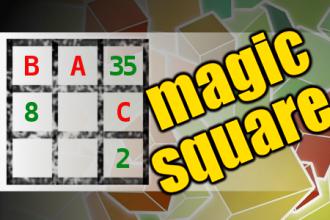MAGIC SQUARE: Calculate A*B+C
The aim is to place the some numbers from the list (2, 4, 8, 29, 31, 35, 54, 55, 56, 60, 99) into the empty squares and squares marked with A, B an C. Sum of each row and column should be equal. All the numbers of the magic square must be different. Find values for A, B, and C. Solution is A*B+C.Correct answers: 1
#brainteasers #math #magicsquare

A man standing at a bus stop w...
A man standing at a bus stop was eating a hamburger. Next to him stood a lady with her little dog, which became very excited at the smell of the man's supper and began whining and jumping up at him.
The man noticed this, in fact he was getting rather annoyed at the dog.
"Do you mind if I throw him a bit?" said the man to the lady.
"Not at all," she replied, whereupon the man picked the dog up and threw it over a wall.
The man noticed this, in fact he was getting rather annoyed at the dog.
"Do you mind if I throw him a bit?" said the man to the lady.
"Not at all," she replied, whereupon the man picked the dog up and threw it over a wall.

